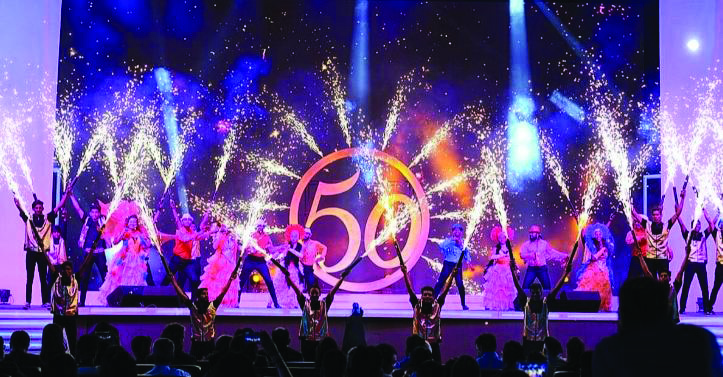Goa is abuzz with excitement as vintage bike and car owners, users, collectors and fans are decking […]

PARRIKAR WILL BE MISSED AT 50TH IFFI!
Nov 16- Nov 22 2019, Stray Thoughts November 15, 2019GOA SPECIAL: The regional cinema of Goa will be honoured at IFFI this year, as a package of films in Konkani will be showcased at IFFI 50 for the first time as a section named ‘The Goan Story’
BY RAJAN NARAYAN
AND a few stray thoughts for yet another Saturday. For a Saturday following the week when the Ayodhya verdict did not caused any ripples in Goa. For a Saturday following the week when we are entering a new era which might transform the world. For a Saturday following the week when Chief Minister Pramod Sawant seem to be more interested in the merger of Dodamarg in Maharashtra with Goa than the development of Goa. For a Saturday following the week when it was finally decided that a firm from Netherlands would move the ‘Nu Shi Nalini’ out of Marivel beach. For a Saturday preceding the week when Goa will celebrate not only IFFI but also Serendipity.
AYODHYA
And a few stray thoughts on the Ayodhya verdict on the demolition of the Babri Masjid.
The Supreme Court, headed by Ranjan Gogoi, announced its verdict on a batch of petitions which included the demand for allotment of the 2.6 acres of disputed land, on which the Babri Masjid had been originally built, to the Sangh Parivar.
The Sangh Parivar under the leadership of LK Advani had demanded 14 years ago that a Ram temple should be built on the site of the Babri Masjid. This was the provocation for demolishing the Babri Masjid which, according to the Sangh Parivar, was built on the site of the original Hindu temple dedicated to Lord Ram. The Sangh Parivar has also been claiming that Ayodhya is the birth place of Sri Ram.
In his last verdict before retirement, Chief Justice Ranjan Gogoi conceded the Sangh Parivar’s demand that the 2.6 acres of disputed land where the Babri Masjid was demolished should be given to the majority community. This was a tacit acceptance of the claim of the Sangh Parivar that the Babri Masjid was built after demolishing a then-existing Hindu temple.
The Supreme Court however strongly condemned the demolishing of the Babri Masjid. In compensation the Supreme Court directed that five acres of land should be allotted to the Muslim community outside the disputed area to build a masjid.
There were some strong protests in various parts of the country with the exception of Goa, proving once again that Goa is the most cosmopolitan state in the country. Migrants, including Muslim migrants even from UP and Ayodhya, are least bothered about either the demolition of the Babri Masjid or the construction of the Ram Mandir.
The indifference to the Supreme Court judgment is unusual as Goa has a sizable Muslim population. The Muslim population in Goa, which was less than 1% at the time of Liberation, is estimated to have gone up to 14 to 16%. The only reflection of the huge increase in the Muslim population is the addition to the number of mosques and burial grounds. Though there is some conflict between Muslim migrants and Goans, surprisingly it is between the Catholics and Muslims. Most of the migrants have started settling in South Goa where there are disputes about allotting land to Muslims for mosques and madrassas.
To prevent any conflict in the days immediately post the verdict, Article 144 was enforced all over the country. Article 144 prevents the gathering of more than four people and bans processions. However Goa is so well known for its communal harmony that the Collector granted an exemption from Article 144 so that the Milad un-Nabi rally could be held peacefully in Goa on Sunday, November 10, 2019.
Goa is possibly the only state which has not witnessed a communal riot excepting for a small skirmish in Curchorem over the conversion of a residential house into a madrasa. But as in all other parts of the country the conflict between the Sunnis and the Shias is present in Goa also.
5G CHANGES
And a few stray thoughts on the major changes happening in our lifestyles.
It began with the agricultural revolution when the primary occupation was farming. Then came the industrial revolution, when the pattern of life changed with the bulk of the population working in factories which produced a whole range of goods from clothes to cars in assembly lines. Then we saw the electronic revolution where humans were substituted by machines which automatically performed the jobs that humans used to perform. And now we are on the verge of a new era of human civilization which can only be described as the AI revolution.
Our normal intelligence is being increasingly replaced by AI which will now define the way we work and the way we live. When it comes to work, robots will substitute humans on the shop floor and will make cars and jeans much faster than at present.
Even better, within the next five years we may not have to worry about finding drivers at extortionate prices or see wars between private taxi drivers and GoaMiles as there will be no drivers. Experimental self driving cars have already been successfully tested not only in the United States but even in India, where both the Tatas and Mahindras have built prototypes of electric driverless cars.
Already in the financial world, banks have been replaced by ATMs and demand drafts by National Electronic Financial Transfers (NEFT). Retail has changed with the friendly neighbouring kirana (grocery) shops giving way to online marketing whether it is fashion, electronic goods or even food. You don’t have to cook, you can have your food delivered at your home by one of the food aggregators.
All this will become more and more rapid as we move from 4G to 5G or even 6G which is the speed at which the internet works. The new revolution will also change our life styles as we will be able to operate our domestic gadgets from the office through our smart phones. In fact most offices may vanish as the work will be done from the comfort of your home.
Many expressions are floating around like AI, Big Data etc. In the world of smart phones starting from Facebook now you have Instagram, Whatsapp, Twitter and several other forms of communication to each other. The flip side is that these new devices can be misused as was done allegedly by Russia to rig the US elections in favour of Donald Trump the US President. Indeed the US President is facing impeachment or removal from office for his actions. The latest misuse is the discovery that the Indian government has used Israeli malware, Pegasus, to spy on over a thousand dissident India citizens, including Priyanka Gandhi.
Forget about understanding the details of the changing technologies. Most of us do not know how they work. When a smart phone claims it is smarter than the others or that it is the smartest phone as claimed by Apple, on what basis are the claims made? What is YouTube and how does it work and why has it become the biggest revenue earner for Facebook? There are hundreds of apps coming out every day. The majority of them may be harmless, though all are addictive. But there are new violent challenges and games like Blue Whale and PUBG that are in the market which can cause harm and become a breeding ground for terrorism. Which is why in Goan Observer we have decided to change our focus to the new world so that people will know what is happening and how to prevent any harm or threats that new technology may pose.
DODAMARG
And a few stray thoughts on Chief Minister Pramod Sawant reportedly owning more than 4,000 acres in Dodamarg, the last district in Maharashtra.
When you come by bus from Mumbai, Dodamarg is the last stop before you enter Goa. There is in fact a checkpost to find out if you are carrying items like gutka which are banned in Goa. Dodamarg is the least developed of the districts in Maharashtra. It does not have a school, college, or even a hospital. Electricity is very erratic and there is severe water shortage. Not surprisingly, the population is very low and land is cheap. The CM has been smart enough to buy land at a very low price in the expectation that it will be developed when Goa becomes house full.
Dodamarg does not have attractions of any sort. It has no beaches and no greenery, being barren. Maharashtra has neglected Dodomarg as it has only one seat and it does not make any difference to who forms the government. This is unlike Amboli which is dominated by Narayan Rane and is the home of the Alphonso mango.
The purchase of large amounts of land by the CM in Dodamarg has sparked speculation that he may want to merge Dodomarg with Goa. This will be sweet revenge for Goa as Maharashtra was defeated when it tried to merge the whole of Goa with Maharashtra. While admitting that he has purchased land, Sawant claims that it was much less than the thousands of acres spoken about and that he bought it with his own money. Incidentally, it is not widely known that Sawant is married and that his wife is a school teacher. The family has maintained the tradition set by Parrikar of staying in Sanquelim in the family house rather than the chief minister’s official residence at Altinho, Panaji.
FRESH HOPES FOR NALINI
And a few stray thoughts on fresh hopes of the departure of Nalini who has been berthed near the Raj Bhavan for the last 20 days.
Apparently none of the Singapore parties who were requested to help out have agreed. Finally the task of removing Nalini and sending her back to the MPT has been entrusted to a Netherlands company called Marine Masters.
The difference between experiments and experts is that experts know their jobs. The focus of both the chief minister and the MPT has been on pumping out the naphtha from Nalini at the spot where it has got stranded. Marine Masters on the other hands are worried that there may be cracks at the bottom of the ship. The naphtha in the ship might leak from the bottom into the sea affecting marine life and us. So unlike all the other experts including the Directorate of Shipping, Master Marinas have first decided to examine the bottom of the ship to see if there are any holes or cracks. Their focus will be on repairing the cracks if any at the bottom of the ship, and then, contrary to earlier proposals, Marine Masters will be tugging the ship back to the MPT harbour where it lay unattended for over three months.
This seems to be very logical as if there is any tragedy it should be the MPT which should suffer. It is common sense that any leaks in the ship should be repaired before pumping out the Naptha. The only sore point is that the cost has now gone up by 500%. As against the early estimate of 4 crore the cost of refloating Nalini and escorting the lady back to MPT will be as much as25 crore.
CULTURAL EVENTS AGAIN
And a last stray thought on the two major cultural events that Goa will be celebrating soon.
The more important of these is the International Film Festival of India which will celebrate its 50th anniversary. It will also mark the 15th anniversary of Goa becoming the permanent venue for IFFI.
In 2004 Mr Atal Bihari Vajpaye, after whom the Atal Sethu bridge is named, was the PM. The former Foreign Affairs Minister, the late Sushma Swaraj, was the Information & Broadcasting Minister. It was Manohar Parrikar who persuaded Sushma Swaraj to hold IFFI in Goa. This was just six months before the scheduled date for IFFI which has been normally held in the last week of November.
Initially when IFFI was shifted to Goa it lasted for two weeks — from November 23 to December 3. It was subsequently cut short to eight days from November 23 to 30 to avoid a clash with the exposition of St Francis Xavier.
It is to late Parrikar’s credit that he single-handedly created the infrastructure for IFFI within six months. Goa did not even have a decent theatre for screening IFFI films. The conditions for holding IFFI are governed by an international body which even defines the quality of the screens and the storage facilities for films reels. Many of the films shown at film festivals are old classics which have to be handled very carefully.
Parrikar took the initiative to build a multiplex for increasing the screening capacity within six months. This is the only multiplex in the country owned by the government. It was leased out to Inox to run it during IFFI as the government did not have the experience.
Parrikar spend over `100 crore over the last 15 years in renovating not only the Kala Academy complex but the whole of Panjim. The original plan was to beautify Panjim from the bus stop to Dona Paula. Parrikar also built a jetty at the Kala Academy so that delegates could travel directly by boat from the Taj where they stayed to the IFFI venue. The jetty which was repeatedly renovated was never used.
Parrikar kept promising that a new convention hall and a complex would be build in Dona Paula for this year’s IFFI. No work has even started on this project. The only consolation is that thanks to the construction of the Dr Shyama Prasad Mukherjee Indoor Stadium a larger number of people can watch the opening and closing ceremony.
Parrikar also did a lot of damage to realize his obsession with making Goa the permanent destination for IFFI. The old vegetable market was destroyed to create space for Inox. The former GMC hospital, a historical structure, was taken over to accommodate the offices of the various agencies involved in IFFI.
It must be clarified that though the ESG is the local host for IFFI, the event belongs to the Director of Film Festivals. The bulk of the expenditure has been incurred by Goa with the exception of prize money and the accommodation and travel of jury members and guests invited by the I&B Ministry. There have been major improvements in the ticketing systems with the introduction of e-booking. But part of the mess continues as film delegates either arrive late or change their mind about seeing a film. From last year it has been declared that people without tickets will be permitted into the auditorium if ticket holders are not in their seats by screening time.
IFFI this time will miss two veterans who played a major part in building the festival. One of this was the late Vishnu Wagh, who was Vice-Chairperson of the ESG. The other is Rajendra Talak who suddenly resigned immediately after Pramod Sawant took over. If IFFI events have been running smoothly without complaints from media and VVIPs the credit goes to the excellent public relation skills of Vrindavan Raikar the his office team.
There’s been a proposal to make and be screen a short film as homage to the late Manohar Parrikar. Whether this is appropriate for an international event is debatable.
The second major event that Goa will witness is the third edition of Serendipity which starts after IFFI comes to a close. It is a multicultural festival promoted by the Munjals, owners of Hero Motorcycle. It includes art, music, drama multimedia and the biggest stars from India and abroad. Not filmstars but cultural stars — who have made significant contributions and are experimenting with new art firms and fusion between the existing art forms.
The star of this year’s Serendipity is Solomon Souza, grandson of world famous painter FN Souza, who will be literally painting the walls of Panjim. After three months of staying within the house due to the continuous rains, Goans will be now flooded with art and culture.















